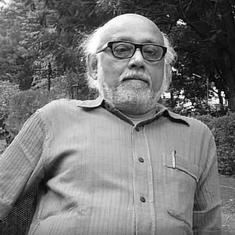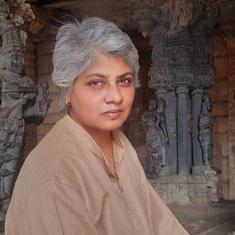In Dilip Kumar’s cinema, the romantic tragedies feature mourning the death of a noble human being, who is superior to other people in society but weak as far as his social milieu is concerned. His actions of insistence and endurance do not violate any humanistic norms once the postulates of romance have been established.
This hero is exceptional in his society but extremely isolated and alienated. He has passions and his ability to express himself is far greater than that of ordinary people, but what he does face is social criticism. He represents a blend of the inevitable and the nonconformity with the social norms which is particular to tragedy in general. Often, it is simply a matter of being a morally strong character in an exposed position.
In literature, cinema, and theatre, the ‘Tragic Hero’ is concerned with a character’s separation from society. And in it, the tragic hero undergoes suffering, sacrifice or death and evokes pathos in a realistic narrative. He is in a strong conflict with a ruthless figure, and he becomes a helpless victim and is often broken by a conflict between his inner and outer worlds. He can be but is not necessarily weaker than the average person; yet, he suffers severe persecution at the hands of a deranged society. He is a perfectly innocent victim excluded from human milieu.
Dilip Kumar’s tragedies treated pity through intense pathos and presented him as a helpless man, which appealed immensely to the audience’s sympathy. The audience saw his suffering as being utterly against the long-cherished social ideas of basic humanism and justice. Second, the audience found that the happenings in their hero’s life were quite similar, in some way or the other, to what it found in its own experience. A viewer felt he is, or was, or could be in the same situation sometime, as the situations are being judged by the norms of greater freedom in the narrative of a film.
In the classical period, as well as later, the highly moving death scenes enacted by Dilip Kumar, as in the climax of his fourteen films, were a singular trademark of his screen persona and the death syndrome was one of the most compelling points of excellence in his inventory of skills. In these films, the protagonist, after undergoing an unending struggle and suffering to uphold his convictions, meets his death virtually, as if he is on a sacrificial altar, including death as the final culmination of the tragic journey in love and life at large.
In fact, many characters played by Dilip Kumar, at least, in the classical period, tended to show that irrespective of whether one is rich or poor, young or old, life is essentially futile; it must be lost on some context or the other. As the character dissolved his identity in suffering and finally in death, it indeed became a complete annihilation of his being.

One is not sure if the death scene in his films of that period was a consciously designed ploy by the legend and his scriptwriters to precipitate the culmination of the pent-up emotional flux built up in the story and to negotiate with the already emotionally charged audience, the catharsis of suffering and sacrifice, foretold in the narrative. This culmination of the morbidity of the theme helped the audience get a sudden release from the intense melancholic experience which otherwise looked perpetual and unending.
Moreover, through death, the actor not only metaphorized a life worth living but also got the sanctity according to the Indian philosophy, held deep in the psyche of the common man, of sacrificing one’s life for a cause, an act, which eventually leads to the salvation of the soul. Thus, death becomes a celebration, met through a prolonged ritual of departure, often in the arms of the dear one, and at times even with the community surrounding the dying man.
No other artist, except perhaps Meena Kumari, labelled as the ‘Tragedy Queen’ of Indian cinema, had this ability to transform a dying character into such a complex aura of emotions. In several films of this period, Dilip Kumar’s characterizations were built around the premise of unrequited love, which defined some of the basic traits of the actor’s personality on celluloid. His characterizations determined the very texture of these films.
These characters were centred on a woman’s love – the compulsive longing, the short-lived victory, and the aftermath of separation, pain and suffering. They seemed to be interpreting the larger society’s suffering as a personal grief. This, in essence, represented an agonized, self-pitying and self indulgent hero who helped the viewers in releasing their own trapped emotions of helplessness and despair. For the viewers, the inbuilt metaphor of destruction of the self and a perpetual death wish (or the inevitability of overhanging death) had the same appeal as that of the sacrifice of the hero for an intimate or a greater cause.
All the situations in a film had the basic objective of creating a pensive and lugubrious character that appeared to be enjoying his pain but at the same time getting sucked into it. Thus, the source and the nature of the pain looked real and yet remained abstract.
The basic tenets of these films were inspired by the innumerable love legends in which the status quo in society was challenged and provoked through the manifestation of socially forbidden love. This love was internalized by the lovers as suffering, and they would often find their salvation only through the meeting of the souls in heaven after death. Thus, the oriental concept of sacrificing one’s physical form, the body, for a cause underlined the immortality of the soul.
This unfulfilled love for the beloved in the folk tales was a central theme in the medieval Bhakti movement, whose origins can be traced to the passive response of the masses to the feudal oppression. The ultimate emancipation was portrayed as an unending internal suffering against the oppressors. The suffering was rationalized through a greater vision of life in which seeking the attention of the beloved was presented as the sole purpose of life. It did not matter whether one was in the arms of the beloved or was going through separation and suffering.
In these films, childhood love had central importance, located invariably against the backdrop of aristocracy and common people divide. The innocent and delicate craving between two young souls would always become a victim of the tyranny of family elders and subsequently of social inequalities. As childhood lovers reached adulthood, they would carry with them the intense childhood infatuation and undergo the agony of separation, which often found solace in death.
Dilip Kumar’s persona in this period also had another dimension – the one-way love syndrome, which soon was to become a typical feature of Indian cinema. This love was perceived by the sufferer as his only emancipation, virtually the essence of his existence.
Excerpted with permission from Dilip Kumar – The Man Who Became Cinema, Ashok Chopra, Penguin Random House India.










